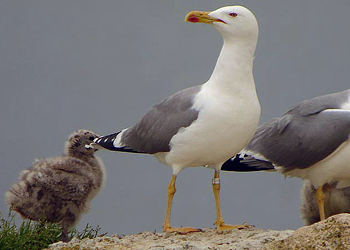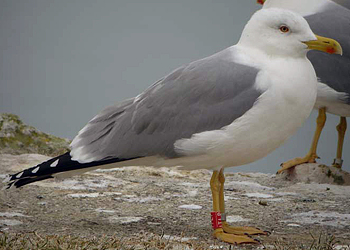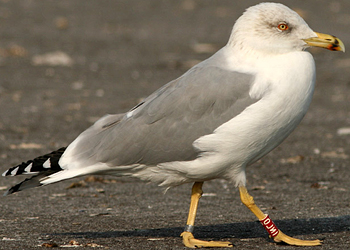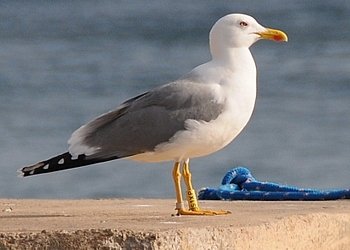 Larus cachinnans
Larus cachinnans
(last update:
Greg Neubauer
Marcin Przymencki
Albert de Jong
Mars Muusse
adult cachinnans: June
In 2006, Ronald Klein & Grzegorz Neubauer published an article in Vogelwelt about Larus cachinnans and L. michahellis. The original article (PDF) is in German, translated by Mars Muusse. "We" in the text below refers to the original authors. If any (translation) errors occur in this text, please let me know and mail to marsmuusseatgmaildotcom.
BELOW: PART 1 OF THE PAPER
Influxes of Caspian Gulls Larus cachinnans and Yellow-legged Gulls L. michahellis into northern Central Europe – origin, causes, course and trend.
BY: R. Klein & G. Neubauer.
IN: Vogelwelt 127: 91–97.
Abstract
Based on recoveries of ringed birds, the seasonal occurrence of Caspian Gull and Yellow-legged Gull in the German and Polish lowlands is described. Both taxa were recorded in highest numbers in late summer and autumn, with the majority of birds being juveniles. Whereas Caspian Gulls in Poland peaked in July and winter, maximum numbers from Germany fell into autumn with a lack of high concentrations in winter. Ringed Yellow-legged Gulls were mainly observed from July to November, but did not occur in Poland and at the German Baltic Sea coast in winter. The origin of the majority of Yellow-legged Gulls observed in northern Central Europe is the northern Adriatic Sea (Italy, Croatia), but a few also came from Tuscany (Italy) and Switzerland. Possible causes of influxes are discussed and their probable routes shown in maps. It appears that Caspian Gull is colonising Central Europe as a regular breeding bird, and it is expected that in future this species will outnumber Herring Gull and Yellow-legged Gull especially in the eastern part of the inland study area.
1. Introduction
In recent years, European gulls more than any other bird group have acquired attention of experts. The mere existence of three different pale-mantled large gull species is now fully recognized and is reflected in the latest standard works (Bauer et al, 2005, Malling Olsen & Larsson 2003). Furthermore, it is now clear that Caspian Gulls Larus cachinnans regularly reaches Western Europe in autumn and Yellow-legged Gull L. michahellis may migrate to southern Scandinavia. It is particularly exciting that both species also expand their breeding range. Gulls of Mediterranean origin now nest regularly in southern Germany and Caspian Gulls in southeastern Poland. Mixed colonies have emerged in Belarus, along the middle Vistula River and in Lausitz where Herring Gull L. argentatus breeds together with the taxa discussed here; and they also hybridise (Klein 2001, Neubauer et al 2006, Yakovets 2006). Caspian Gull is currently colonizing the central European interior. In Lausitz the species was first noticed around 1995, with single individuals in the local large gull colony Kleinkoschen (which by that time, according to the tables in Liebers 2000, held approximately 75% L. argentatus, the rest L. michahellis). Nowadays, Caspian Gull seems to represent a significantly higher proportion (Klein et al. in prep.).
Klein (1994) already published information about the phenology of Caspian and Yellow-legged Gulls, based on ring recoveries. By that time, Steppe Gulls were present along the German Baltic coast year-round, while Yellow-legged Gulls were almost only present in summer and fall. Over the years, at local level the large gull populations were examined on type and age composition (Steiof 2006). The identification of Caspian and Yellow-legged Gulls in the field was difficult until recently more data became available on phenotypic characteristics, especially from ringed specimens of both species. The start of several colour-ringing programs strongly increased observations of ringed birds and a more detailed picture of the species evolved, with much help from many observers throughout Europe. Now it is time to put the occurrence of both taxa in a larger context.
| Table 1. Number of recoveries of ringed Caspian and Yellow-legged Gulls in certain areas of Central Europe (by 31 December 2004). | |||
German Baltic Sea coast |
inland Germany |
Poland |
|
Caspian Gull |
32 |
30 |
66 |
Yellow-legged Gull |
120 |
117 |
84 |
2. Material & method
For this paper, we analyzed all available (full) ring-readings from northern Germany and northern Poland, exclusively when Caspian and Yellow-legged Gulls were ringed as unfledged pulli. Observations of ringed birds started in 1991 in the German Baltic, similar activities in interior Germany began around 1995 and in Poland from 1999. The southern border for our research is about 52nd latitude, which runs through the German-Polish lowlands, roughly a line Münsterland – Harz – Niederlausitz – central Poland (Lodz). However, data from the Ruhrgebiet area and the south of Sachsen-Anhalt (just south of 52 ° N) were also considered.
In the paragraph ‘results’ we group together ring observations of the German Baltic Sea (Schleswig-Holstein, Mecklenburg-Vorpommern), inland Germany (Berlin-Brandenburg, Halle-Leipzig, Hannover, Ruhr) and Poland (Gdansk, Torun, Konin). We did not include the very limited data from the North Sea, because there is little sense to consider them separately. On December 31 2004, our data set comprised 449 ring readings (Table 1). Multiple readings of the same ring were only included for a location when calendar month was different, or within a month when locations were at least 10 km distant apart. The underlying data does not correspond to the actual number of identified ringed individuals.
Most observations came from landfills or resting places such as bridges, pontoons and birds resting on thin ice.
Birds from mixed colonies (ring codes Gdansk, Hiddensee and Minsk) were not taken into consideration, even if birds could be clearly classified on phenotypic characteristics. Also, ring readings of Caspian Gulls from southeast Poland have been neglected, because this breeding population holds some Yellow-legged Gulls and hybrids (Neubauer et al. 2006). Thus, the present review concerns only birds from the core areas of their distribution, Caspian Gulls with Moscow and Kiev rings; and Yellow-legged Gulls with Paris, Radolfzell, Bologna, Zagreb, Ljubljana and Sempach rings.
When interpreting the data, it is important to note the various activities and preferences of individual observers. Some places can be checked regularly; still it may be difficult or impossible to read the inscription of metal rings, while color rings can be read easily. This could result in extreme biases, for instance high numbers of colour-ringed Croatian and Italian Yellow-legged Gulls are recorded, but almost none (only metal-ringed) Caspian Gull from the lower reaches of the Dnjepr. Therefore, analyses of statistical data from this set may be questionable. We have data about the annual number of ringed gulls for certain areas, but for a detailed quantitative analysis we have to set this in relation to the relevant size of the entire breeding population. To make results comparable, all the graphics are in percentages not absolute numbers and monthly percentages aggregate for a year for specific regions.
The earliest observations for first calendar year large gulls away from the breeding colonies fall in the first decade of July; therefore, the beginning of a "Gulls Year" in our charts is set 1st July.
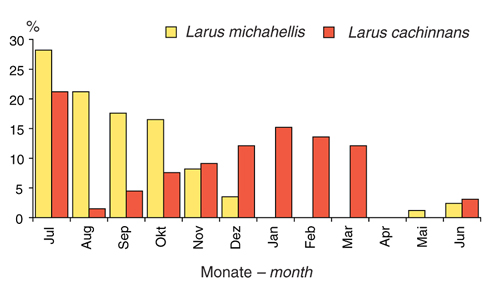
Fig. 1: Seasonal distribution of ring identifications of Caspian and Yellow-legged Gulls in Northern
Poland (1991–2004; n = 150).

Fig. 2: Seasonal distribution of
ring identifications of Caspian and Yellow-legged Gulls at
the German Baltic coast (1991–2004; n = 152).
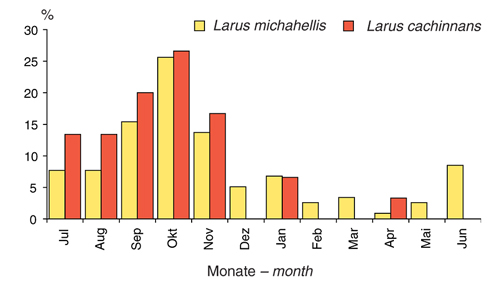
Fig. 3: Seasonal distribution
of ring identifications of Caspian and Yellow-legged Gulls
in inland northern German (1991–2004; n = 147).
3. Results
In Poland the occurrence of Caspian and Yellow-legged Gulls peak in July (Fig. 1). For Yellow-legged Gulls, July is the peak and the number of recorded ringed gull continuously decreases towards the winter when they almost completely disappear from the region. Caspian Gulls have two peaks: one in July and another in the winter months. In May/June when adults are breeding, immature birds start to appear again. Numerous ring readings evidently support that the same places are often visited year after year. The distribution pattern of gulls on the German Baltic coast is more or less similar (Fig. 2). The summer peak is only slightly shifted and Caspian Gulls are found more often than in the early 1990s (cf. Klein 1994).
In interior north German the pattern is somewhat different. The summer peak gradually culminates here for both species in October, and in winter there is no evidence of another peak for Caspian Gulls (Fig. 3). Interestingly, Yellow-legged Gulls are regularly present well into winter, which is especially true for West Germany. First calendar year (1CY) birds of both species may reach the study area shortly after fledging. Already on 12th July, a juvenile ringed Caspian Gull from Ukraine was recorded in Mecklenburg-Vorpommern, Germany. The earliest such evidence for interior German dated 27 July (Eberswalde), and for Poland it was the 26th July. In Poland we have a total of nine ring readings for 1CY Ukrainian Caspian Gulls from the last decade of July. However, for August they are totally absence so far, this is probably related to the low reading activities for this month (T. Iciek, pers. comm.), three 1CY birds found dead in the north east of the country illustrate they do occur in the region (comm. ringing centre Gdansk).
The earliest ring reading for 1CY Yellow-legged Gull in the area under consideration dates from the 21th July (Eberswalde / Brandenburg). In Poland, the earliest ringed juvenile bird appeared on 25th July and on 31st July at the German Baltic coast. Especially in Poland, the concentration of ringed 1CY Yellow-legged Gulls very much accumulates on the last 10 days of July and the first decade of August (17 of 35 readings of 1CY birds). While almost all Yellow-legged Gulls depart in fall from the north of Central Europe, some birds remain in winter in interior Central Europe. This is supported by ring readings: all (!) available ring readings between January and March originate from Germany’s western counties. Generally the appearance of 1CY birds dominates in summer, and this is even more apparent in Caspian Gulls.
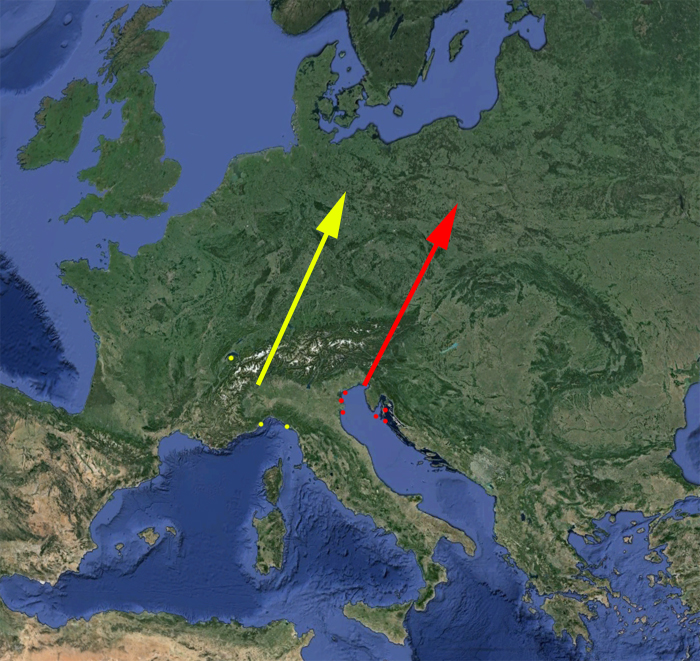
The origin of ringed Yellow-legged Gulls is almost exclusively from the northern Adriatic Sea. Birds originating from the Ligurian Sea and Switzerland were recorded only in Germany. Caspian Gulls from Ukraine were usually ringed in Kaniv’s Dnjepr reservoir (49,45,46N 31,27,52E), but also a few birds originated from the northern Black Sea coast and the Sea of Azov. These recordings more or less reflect the ringing activities in Eastern Europe. A ringed bird which was recorded twice in Mecklenburg-Vorpommern hatched at the lagoons of the Romanian Danube Delta, which is the contact zone for Caspian and Yellow-legged Gulls, both species do not hybridise here as they have their own breeding ecologically (Small & Buchheim, 1997) and also differ in molecular genetics (Lieber et al. 2001).
Our ring readings data is not appropriate for conclusions on the true ratio of occurrence between Caspian and Yellow-legged Gulls, for reasons already mentioned, even if numbers for species are identical, when we compare the Baltic Sea and inland Germany (Table 1); and even if, as expected, Caspian Gull occurs more frequently in Poland than in Germany.
Late summer observations around the year 2000 made on landfills at the Baltic Sea by one of the authors, gave Ronald Klein the impression that the proportion of the Yellow-legged Gull had decreased compared with the 1990s. For instance, August/September 1995 daily maximum numbers were estimated to be 50 Caspian and 80-100 Yellow-legged Gulls (mostly 1CY birds) among about 5000 Herring Gulls, and these were no extraordinary figures. It has to be mentioned no systematic counts were conducted, because ring readings on large gulls always had priority. Apparently, five years later Caspian Gulls were recorded about twice as often as Yellow-legged Gull in late summer. Currently the feeding situation has deteriorated significantly and former figures are generally not achieved anymore. Since June 2005 it is not allowed anymore to landfill untreated domestic waste. Only a few landfills are still operating and in the best case only a few hundred large gulls are present around the composting area. Nowadays you can find gulls among lapwings, loosely distributed even on dry farmland (a new phenomenon for large gulls), and birds more often appear at waterbird feeding stations in tourist and fishing ports like Warnemünde and Burgstaaken / Fehmarn where they can be really "tame". Apparently a change of feeding ecology seems to take place at present. Whether this will turn out to have long term selective advantages for the better-fitted terrestrial Caspian Gull (Klein 2001) remains to be seen.
END OF PART 1
CONTINUE PART 2: DISCUSSION

Above: Looking southwards over location Fanel, Switzerland, with Lake Geneva on the right. Enthusiastic ringing team ringing many pulli every year, of which part migrate north and north-west, reaching Germany, Denmark and the Netherlands as early as late July. By October they follow the Atlantic coast southwards again.
Below: Looking northwards into the Northern Adriatic Sea, with left N Italy and the balkan on the right. The Croatian coast holds many many islands and inlets, origin for Yellow-legged Gull michahellis turning up in Poland. One of the larger Croatian islands is Krk with small adjacent islands where many birds are ringed darvic red or yellow starting with S.

 Larus cachinnans adult 6L1B June 01 2009, Kretuonas lake, Lithuania. Picture: Vytautas Pareigis.
Larus cachinnans adult 6L1B June 01 2009, Kretuonas lake, Lithuania. Picture: Vytautas Pareigis. Larus argentatus sensu lato P429 adult, 2012-2013, Zastow Karczmiski, Poland & February 2014, Bucharest, Romania. Likely argentatus.
Larus argentatus sensu lato P429 adult, 2012-2013, Zastow Karczmiski, Poland & February 2014, Bucharest, Romania. Likely argentatus. Caspian Gull cachinnans 9.W 7CY-8CY, April - July 2020-2021, Gatovo - Minsk, Belarus. Picture: Irina Samusenko.
Caspian Gull cachinnans 9.W 7CY-8CY, April - July 2020-2021, Gatovo - Minsk, Belarus. Picture: Irina Samusenko. Larus cachinnans adult, June 02 2010, Dambovita river - Bucharest. Picture: Cristian Mihai.
Larus cachinnans adult, June 02 2010, Dambovita river - Bucharest. Picture: Cristian Mihai.below: set of pictures of eastern cachinnans, June 2011, Aktogay, East-Kazakhstan Province. All pictures by Gabor Papp.
Eastern cachinnans has more black-less white in the wingtip.
 Larus cachinnans adult, June 07 2011, Aktogay, East-Kazakhstan Province (46,57N 79,40E). Picture: Gabor Papp.
Larus cachinnans adult, June 07 2011, Aktogay, East-Kazakhstan Province (46,57N 79,40E). Picture: Gabor Papp. Note short looking yellowish legs.
 Larus cachinnans adult, June 09 2011, Aktogay, East-Kazakhstan Province (46,57N 79,40E). Picture: Gabor Papp.
Larus cachinnans adult, June 09 2011, Aktogay, East-Kazakhstan Province (46,57N 79,40E). Picture: Gabor Papp. Homogeneous gery tone on upperparts. Many immatures.
 Larus cachinnans adult, June 07 2011, Aktogay, East-Kazakhstan Province (46,57N 79,40E). Picture: Gabor Papp.
Larus cachinnans adult, June 07 2011, Aktogay, East-Kazakhstan Province (46,57N 79,40E). Picture: Gabor Papp. Note pale iris.
 Larus cachinnans adult, June 07 2011, Aktogay, East-Kazakhstan Province (46,57N 79,40E). Picture: Gabor Papp.
Larus cachinnans adult, June 07 2011, Aktogay, East-Kazakhstan Province (46,57N 79,40E). Picture: Gabor Papp. Dark iris.
 Larus cachinnans adult, June 07 2011, Aktogay, East-Kazakhstan Province (46,57N 79,40E). Picture: Gabor Papp.
Larus cachinnans adult, June 07 2011, Aktogay, East-Kazakhstan Province (46,57N 79,40E). Picture: Gabor Papp. Dark iris.
 Larus cachinnans adult, June 07 2011, Aktogay, East-Kazakhstan Province (46,57N 79,40E). Picture: Gabor Papp.
Larus cachinnans adult, June 07 2011, Aktogay, East-Kazakhstan Province (46,57N 79,40E). Picture: Gabor Papp. Black on P3-P10 (left wing with tiny spot on P2 as well).
 Larus cachinnans adult, June 07 2011, Aktogay, East-Kazakhstan Province (46,57N 79,40E). Picture: Gabor Papp.
Larus cachinnans adult, June 07 2011, Aktogay, East-Kazakhstan Province (46,57N 79,40E). Picture: Gabor Papp. Note black on P1-P10.
 Larus cachinnans adult, June 07 2011, Aktogay, East-Kazakhstan Province (46,57N 79,40E). Picture: Gabor Papp.
Larus cachinnans adult, June 07 2011, Aktogay, East-Kazakhstan Province (46,57N 79,40E). Picture: Gabor Papp. Full subterminal band on P10.
 Larus cachinnans adult, June 07 2011, Aktogay, East-Kazakhstan Province (46,57N 79,40E). Picture: Gabor Papp.
Larus cachinnans adult, June 07 2011, Aktogay, East-Kazakhstan Province (46,57N 79,40E). Picture: Gabor Papp. Tiny mirror on P9.
 Larus cachinnans adult, June 07 2011, Aktogay, East-Kazakhstan Province (46,57N 79,40E). Picture: Gabor Papp.
Larus cachinnans adult, June 07 2011, Aktogay, East-Kazakhstan Province (46,57N 79,40E). Picture: Gabor Papp. Black on P4-P10.
 Larus cachinnans adult, June 07 2011, Aktogay, East-Kazakhstan Province (46,57N 79,40E). Picture: Gabor Papp.
Larus cachinnans adult, June 07 2011, Aktogay, East-Kazakhstan Province (46,57N 79,40E). Picture: Gabor Papp. Medium white tongue with angular end (P10 black > white).
 Larus cachinnans adult, June 07 2011, Aktogay, East-Kazakhstan Province (46,57N 79,40E). Picture: Gabor Papp.
Larus cachinnans adult, June 07 2011, Aktogay, East-Kazakhstan Province (46,57N 79,40E). Picture: Gabor Papp. P1 growing, P2 missing, P3-P10 old.
 Larus cachinnans adult, June 07 2011, Aktogay, East-Kazakhstan Province (46,57N 79,40E). Picture: Gabor Papp.
Larus cachinnans adult, June 07 2011, Aktogay, East-Kazakhstan Province (46,57N 79,40E). Picture: Gabor Papp. P1 growing, P2-P10 old / P1-P10 old.
 Larus cachinnans adult, June 07 2011, Aktogay, East-Kazakhstan Province (46,57N 79,40E). Picture: Gabor Papp.
Larus cachinnans adult, June 07 2011, Aktogay, East-Kazakhstan Province (46,57N 79,40E). Picture: Gabor Papp. Larus cachinnans adult, June 07 2011, Aktogay, East-Kazakhstan Province (46,57N 79,40E). Picture: Gabor Papp.
Larus cachinnans adult, June 07 2011, Aktogay, East-Kazakhstan Province (46,57N 79,40E). Picture: Gabor Papp.below: set of pictures of barabensis type, June 2007,Sverdlovsk oblast - SE Urals. All pictures byAnnika Forsten & Antero Lindholm.
Barabensis has more black-less white in the wingtip: on average shorter pale tongue on underside of P10 and darker grey on upperparts. Often they look shorter legged and in rest with 'hanging wings' almost reaching the ground.
 barabensis type adult, June 12 2007, Sverdlovsk oblast - SE Urals. Picture: Annika Forsten & Antero Lindholm.
barabensis type adult, June 12 2007, Sverdlovsk oblast - SE Urals. Picture: Annika Forsten & Antero Lindholm. barabensis type adult, June 12 2007, Sverdlovsk oblast - SE Urals. Picture: Annika Forsten & Antero Lindholm.
barabensis type adult, June 12 2007, Sverdlovsk oblast - SE Urals. Picture: Annika Forsten & Antero Lindholm. barabensis type adult, June 12 2007, Sverdlovsk oblast - SE Urals. Picture: Annika Forsten & Antero Lindholm.
barabensis type adult, June 12 2007, Sverdlovsk oblast - SE Urals. Picture: Annika Forsten & Antero Lindholm.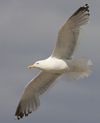 barabensis type adult, June 12 2007, Sverdlovsk oblast - SE Urals. Picture: Annika Forsten & Antero Lindholm.
barabensis type adult, June 12 2007, Sverdlovsk oblast - SE Urals. Picture: Annika Forsten & Antero Lindholm. barabensis type adult, June 12 2007, Sverdlovsk oblast - SE Urals. Picture: Annika Forsten & Antero Lindholm.
barabensis type adult, June 12 2007, Sverdlovsk oblast - SE Urals. Picture: Annika Forsten & Antero Lindholm. barabensis type adult, June 06 2007, Sverdlovsk oblast - SE Urals. Picture: Annika Forsten & Antero Lindholm.
barabensis type adult, June 06 2007, Sverdlovsk oblast - SE Urals. Picture: Annika Forsten & Antero Lindholm. barabensis type adult, June 06 2007, Sverdlovsk oblast - SE Urals. Picture: Annika Forsten & Antero Lindholm.
barabensis type adult, June 06 2007, Sverdlovsk oblast - SE Urals. Picture: Annika Forsten & Antero Lindholm. barabensis type adult, June 04 2007, Sverdlovsk oblast - SE Urals. Picture: Annika Forsten & Antero Lindholm.
barabensis type adult, June 04 2007, Sverdlovsk oblast - SE Urals. Picture: Annika Forsten & Antero Lindholm.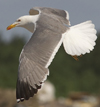 barabensis type adult, June 02 2007, Sverdlovsk oblast - SE Urals. Picture: Annika Forsten & Antero Lindholm.
barabensis type adult, June 02 2007, Sverdlovsk oblast - SE Urals. Picture: Annika Forsten & Antero Lindholm. barabensis type adult, June 02 2007, Sverdlovsk oblast - SE Urals. Picture: Annika Forsten & Antero Lindholm.
barabensis type adult, June 02 2007, Sverdlovsk oblast - SE Urals. Picture: Annika Forsten & Antero Lindholm. barabensis type adult, June 02 2007, Sverdlovsk oblast - SE Urals. Picture: Annika Forsten & Antero Lindholm.
barabensis type adult, June 02 2007, Sverdlovsk oblast - SE Urals. Picture: Annika Forsten & Antero Lindholm.below: large set of pictures of adult cachinnans, June 28 - July 04 2012, Baku landfill, Azerbaijan. All pictures by Chris Gibbins. Pictures from early July are, of course, in the July section.
One may argue about the position of Baku birds: should they be regarded eastern cachinnans or still be classified western ponticus? Just have a look at these pictures...
 Larus cachinnans adult, June 28 2012, Baku landfill, Azerbaijan. Picture: Chris Gibbins.
Larus cachinnans adult, June 28 2012, Baku landfill, Azerbaijan. Picture: Chris Gibbins. Larus cachinnans adult, June 28 2012, Baku landfill, Azerbaijan. Picture: Chris Gibbins.
Larus cachinnans adult, June 28 2012, Baku landfill, Azerbaijan. Picture: Chris Gibbins. Larus cachinnans adult, June 28 2012, Baku landfill, Azerbaijan. Picture: Chris Gibbins.
Larus cachinnans adult, June 28 2012, Baku landfill, Azerbaijan. Picture: Chris Gibbins. Larus cachinnans adult, June 28 2012, Baku landfill, Azerbaijan. Picture: Chris Gibbins.
Larus cachinnans adult, June 28 2012, Baku landfill, Azerbaijan. Picture: Chris Gibbins. Larus cachinnans adult, June 28 2012, Baku landfill, Azerbaijan. Picture: Chris Gibbins.
Larus cachinnans adult, June 28 2012, Baku landfill, Azerbaijan. Picture: Chris Gibbins. Larus cachinnans adult, June 28 2012, Baku landfill, Azerbaijan. Picture: Chris Gibbins.
Larus cachinnans adult, June 28 2012, Baku landfill, Azerbaijan. Picture: Chris Gibbins. Larus cachinnans adult, June 28 2012, Baku landfill, Azerbaijan. Picture: Chris Gibbins.
Larus cachinnans adult, June 28 2012, Baku landfill, Azerbaijan. Picture: Chris Gibbins. Larus cachinnans adult, June 28 2012, Baku landfill, Azerbaijan. Picture: Chris Gibbins.
Larus cachinnans adult, June 28 2012, Baku landfill, Azerbaijan. Picture: Chris Gibbins. Larus cachinnans adult, June 28 2012, Baku landfill, Azerbaijan. Picture: Chris Gibbins.
Larus cachinnans adult, June 28 2012, Baku landfill, Azerbaijan. Picture: Chris Gibbins. Larus cachinnans adult, June 28 2012, Baku landfill, Azerbaijan. Picture: Chris Gibbins.
Larus cachinnans adult, June 28 2012, Baku landfill, Azerbaijan. Picture: Chris Gibbins. Larus cachinnans adult, June 28 2012, Baku landfill, Azerbaijan. Picture: Chris Gibbins.
Larus cachinnans adult, June 28 2012, Baku landfill, Azerbaijan. Picture: Chris Gibbins. Larus cachinnans adult, June 28 2012, Baku landfill, Azerbaijan. Picture: Chris Gibbins.
Larus cachinnans adult, June 28 2012, Baku landfill, Azerbaijan. Picture: Chris Gibbins. Larus cachinnans adult, June 28 2012, Baku landfill, Azerbaijan. Picture: Chris Gibbins.
Larus cachinnans adult, June 28 2012, Baku landfill, Azerbaijan. Picture: Chris Gibbins. Larus cachinnans adult, June 28 2012, Baku landfill, Azerbaijan. Picture: Chris Gibbins.
Larus cachinnans adult, June 28 2012, Baku landfill, Azerbaijan. Picture: Chris Gibbins. Larus cachinnans adult, June 28 2012, Baku landfill, Azerbaijan. Picture: Chris Gibbins.
Larus cachinnans adult, June 28 2012, Baku landfill, Azerbaijan. Picture: Chris Gibbins. Larus cachinnans adult, June 28 2012, Baku landfill, Azerbaijan. Picture: Chris Gibbins.
Larus cachinnans adult, June 28 2012, Baku landfill, Azerbaijan. Picture: Chris Gibbins. Larus cachinnans adult, June 28 2012, Baku landfill, Azerbaijan. Picture: Chris Gibbins.
Larus cachinnans adult, June 28 2012, Baku landfill, Azerbaijan. Picture: Chris Gibbins. Larus cachinnans adult, June 28 2012, Baku landfill, Azerbaijan. Picture: Chris Gibbins.
Larus cachinnans adult, June 28 2012, Baku landfill, Azerbaijan. Picture: Chris Gibbins. Larus cachinnans adult, June 28 2012, Baku landfill, Azerbaijan. Picture: Chris Gibbins.
Larus cachinnans adult, June 28 2012, Baku landfill, Azerbaijan. Picture: Chris Gibbins. Larus cachinnans adult, June 28 2012, Baku landfill, Azerbaijan. Picture: Chris Gibbins.
Larus cachinnans adult, June 28 2012, Baku landfill, Azerbaijan. Picture: Chris Gibbins. Larus cachinnans adult, June 28 2012, Baku landfill, Azerbaijan. Picture: Chris Gibbins.
Larus cachinnans adult, June 28 2012, Baku landfill, Azerbaijan. Picture: Chris Gibbins. Larus cachinnans adult, June 28 2012, Baku landfill, Azerbaijan. Picture: Chris Gibbins.
Larus cachinnans adult, June 28 2012, Baku landfill, Azerbaijan. Picture: Chris Gibbins. Larus cachinnans adult, June 22 2012, Baku landfill, Azerbaijan. Picture: Chris Gibbins.
Larus cachinnans adult, June 22 2012, Baku landfill, Azerbaijan. Picture: Chris Gibbins. Larus cachinnans adult, June 22 2012, Baku landfill, Azerbaijan. Picture: Chris Gibbins.
Larus cachinnans adult, June 22 2012, Baku landfill, Azerbaijan. Picture: Chris Gibbins. Larus cachinnans adult, June 28 2012, Baku landfill, Azerbaijan. Picture: Chris Gibbins.
Larus cachinnans adult, June 28 2012, Baku landfill, Azerbaijan. Picture: Chris Gibbins. Larus cachinnans adult, June 28 2012, Baku landfill, Azerbaijan. Picture: Chris Gibbins.
Larus cachinnans adult, June 28 2012, Baku landfill, Azerbaijan. Picture: Chris Gibbins. Larus cachinnans adult, June 28 2012, Baku landfill, Azerbaijan. Picture: Chris Gibbins.
Larus cachinnans adult, June 28 2012, Baku landfill, Azerbaijan. Picture: Chris Gibbins. Larus cachinnans adult, June 28 2012, Baku landfill, Azerbaijan. Picture: Chris Gibbins.
Larus cachinnans adult, June 28 2012, Baku landfill, Azerbaijan. Picture: Chris Gibbins. Larus cachinnans adult, June 28 2012, Baku landfill, Azerbaijan. Picture: Chris Gibbins.
Larus cachinnans adult, June 28 2012, Baku landfill, Azerbaijan. Picture: Chris Gibbins. Larus cachinnans adult, June 28 2012, Baku landfill, Azerbaijan. Picture: Chris Gibbins.
Larus cachinnans adult, June 28 2012, Baku landfill, Azerbaijan. Picture: Chris Gibbins. Larus cachinnans adult, June 28 2012, Baku landfill, Azerbaijan. Picture: Chris Gibbins.
Larus cachinnans adult, June 28 2012, Baku landfill, Azerbaijan. Picture: Chris Gibbins. Larus cachinnans adult, June 28 2012, Baku landfill, Azerbaijan. Picture: Chris Gibbins.
Larus cachinnans adult, June 28 2012, Baku landfill, Azerbaijan. Picture: Chris Gibbins. Larus cachinnans adult, June 28 2012, Baku landfill, Azerbaijan. Picture: Chris Gibbins.
Larus cachinnans adult, June 28 2012, Baku landfill, Azerbaijan. Picture: Chris Gibbins. Larus cachinnans adult, June 28 2012, Baku landfill, Azerbaijan. Picture: Chris Gibbins.
Larus cachinnans adult, June 28 2012, Baku landfill, Azerbaijan. Picture: Chris Gibbins. Larus cachinnans adult, June 28 2012, Baku landfill, Azerbaijan. Picture: Chris Gibbins.
Larus cachinnans adult, June 28 2012, Baku landfill, Azerbaijan. Picture: Chris Gibbins. Larus cachinnans adult, June 28 2012, Baku landfill, Azerbaijan. Picture: Chris Gibbins.
Larus cachinnans adult, June 28 2012, Baku landfill, Azerbaijan. Picture: Chris Gibbins. Larus cachinnans adult, June 28 2012, Baku landfill, Azerbaijan. Picture: Chris Gibbins.
Larus cachinnans adult, June 28 2012, Baku landfill, Azerbaijan. Picture: Chris Gibbins. Larus cachinnans adult, June 28 2012, Baku landfill, Azerbaijan. Picture: Chris Gibbins.
Larus cachinnans adult, June 28 2012, Baku landfill, Azerbaijan. Picture: Chris Gibbins. Larus cachinnans adult, June 28 2012, Baku landfill, Azerbaijan. Picture: Chris Gibbins.
Larus cachinnans adult, June 28 2012, Baku landfill, Azerbaijan. Picture: Chris Gibbins. Larus cachinnans adult, June 28 2012, Baku landfill, Azerbaijan. Picture: Chris Gibbins.
Larus cachinnans adult, June 28 2012, Baku landfill, Azerbaijan. Picture: Chris Gibbins.